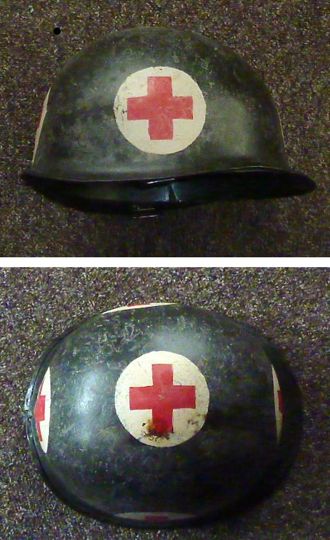|
In 1914, the armies went over to the war of position, from the beginning of 1915, they began to prepare for infantry attacks by hours of artillery fire. It was mainly used shrapnel and shrapnel projectiles, which unfolded a devastating effect on humans. Within a short time, the proportion of wounds increased massively. About a quarter of these wounds were head injuries and thus almost always fatal. So it was hurry to protect the heads of the soldiers.
The German helmets M1916 / M1917
1915, was at the XVIII. Army Corps conducted an investigation, which revealed that 83 percent of the head injuries were caused by splinters, which were mostly tiny. Only 17 percent were caused by infantry shells. This raised the question of a special head protection. In November 1915, the new helmet with a metal thickness of 1 mm had been subjected to bombardment attempts on the artillery shooting range Kummersdorf, which ran to the fullest satisfaction. Even shrapnel balls from a distance could not pierce this helmet.
In December first copies of the helmet were tested at the front. It was followed by the arrangement of mass production, end of January 1916 delivered the ironworks Thale / Harz first helmets to the troops. In February 1916, the introduction of a "steel safety helmet", as the official name, by the Chief of the General Staff of the Field Army, General von Falkenhayn, has.
The inventors were three people. Since both technical and anatomical problems were to be solved, the cooperation of several people was required - Friedrich Schwerd (1872-1953), who was a professor at the Technical University of Hannover, in the war captain of the Landwehr;
- Professor August BEER (1861-1949), marine general physician and consultant surgeon of the XVIII. Army Corps; the simple turning of a night pot made of sheet metal should have inspired him to invent the steel helmet. On August 15, 1915, he encouraged the development of the protective helmet.
The helmet was given the typical and probably unique shape by the wife of Professor Schwerd.
During World War II, the paramedics carried white M35 helmets with a red cross in front, sometimes in the back.
The typical American helmet M1
At the beginning of the Second World War efforts were made on the Allied side to design improved steel helmets. The US War Department refused to sign a contract for the production of two million other M1917 helmets and commissioned the development of a new helmet type. A first draft was rejected because of its too close resemblance to the German steel helmet - one feared fatal confusions in the fight. The issue of the finally retained model, the M1 helmet, was ordered on June 9, 1941. The paramedics also wore M1 helmets, with a red cross: three, four or more crosses were sprayed on. Presented is a helmet with 5 fields. The inlay shows that it is in fact an overmilled MP (Military Police) helmet ... Yes, the helmets varied very much from unit to unit. Often the chief surgeon determined about the appearance of the painting. One author has identified 20 different paintings!
|




